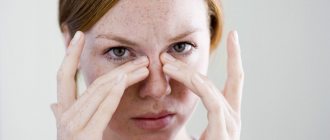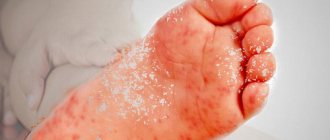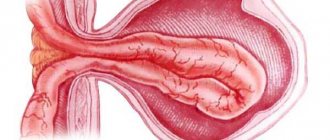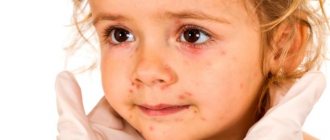A child has irritation on his bottom, a red rough spot: causes, photos
There are many reasons for peeling skin on the buttocks. These may be ailments of internal organs or external causes.
Causes of redness and peeling of the buttocks in a child:
- Failure to comply with hygiene rules
- Contact or diaper dermatitis
- Worms
- Dysbacteriosis
- Candidiasis
- Allergy
- Overheat
A child has irritation on his butt, a red rough spot: causes, photo A child has irritation on his butt, a red rough spot: causes, photo
Diagnosis of anal fissure
Anal fissure is diagnosed by a pediatric proctologist or surgeon.
Even when parents first contact a doctor, a specialist may suspect the presence of this disease. The doctor pays attention to the child’s characteristic complaints, the influence of provoking factors, and the history of the development of the pathological process. A digital rectal examination is required to make a definitive diagnosis. However, in order not to cause psycho-emotional discomfort in the presence of severe pain, the doctor may first limit himself to a simple examination of the anal area. Sometimes the defect can be identified immediately.
If a rectal examination is not performed immediately, it will be postponed to the next visit. The fact is that anal fissures are often a consequence of other proctological diseases, which may not be diagnosed without a full examination. This means that the pathology of the rectum will steadily progress.
To comprehensively assess the patient’s condition, the following tests are performed:
- General blood and urine analysis. Allows you to identify concomitant diseases, primarily anemia, inflammation.
- Coprogram is a microscopic analysis of feces, which is especially important if dysfunction of other parts of the gastrointestinal tract is suspected.
- Blood chemistry. Detects metabolic changes in the body.
- Ultrasound of the abdominal organs. Detects abnormalities in the development of internal organs.
If a concomitant pathology is identified, its treatment is carried out in parallel, which helps to avoid recurrence of the anal fissure.
Red pimples, spots, dots, rashes on a child’s bottom: causes, photos
If you have a newborn baby under 3 months of age, then there is no need to worry. It is at this age that hormonal changes occur in the child’s body. This is a slightly reddish rash, but pimples can also be colorless. If your child is older, the rash is most likely caused by a food or diaper allergy. Avoid diapers containing essential oils and fragrances. Buy hypoallergenic diapers.
Red pimples on the bottom of a 2-5 year old child:
- Hypothermia
- Prickly heat
- Failure to comply with hygiene rules
- Allergy
Red pimples, spots, dots, rashes on a child’s bottom: causes, photos
The child has a red bottom and pussy inside, around the anus: reasons, photos, what to do?
In such cases, it is difficult to say that it is an allergy. Most likely there are problems with the stomach and intestines. Symptoms of the disease can be observed not only in children, but also in all family members.
Causes of redness around the genitals and anus of a child and how to treat them:
- Worms. In this case, there is redness around the baby's anus, which is itchy and may hurt. The child has an increased interest in these places. Worms may be indicated by pain in the right side, as well as poor night sleep. In this case, it is recommended to treat with drugs such as Pirantel, Vermox. For children, the medicine is available in the form of a syrup with a pleasant taste.
- Allergy. Along with redness, a rash or peeling may appear around the anus. In this case, antihistamines Suprastin, Diazolin, Loratadine are prescribed. In addition, the child can only wear cotton underwear. Possible allergens are excluded from food.
- Gastrointestinal diseases . It could be enterocolitis or any disorder. In this case, pain in the abdomen, increased gas formation and loose stools often occur. It is loose stool that can cause irritation around the baby's anus. Antibiotics are used to treat the stomach, and after them it is recommended to restore the microflora with probiotics Linex, Laktovit, Laktiale.
The child has a red bottom and pussy inside, around the anus: reasons, photos, what to do?
Anal atresia
Anal atresia is an anorectal anomaly in which the newborn does not have an anus. The pathogenesis of this unusual phenomenon is a violation of intrauterine development - at the 7th week of development, the cloaca is not divided into the rectum and urogenital sinus. During this period, two openings are formed - the anus and the urogenital canal. Very often, atresia is accompanied by congenital defects of the heart, urinary tract, excretory and genitourinary systems. The disease may be hereditary.
Atresia can be detected during prenatal diagnosis, but it is usually diagnosed during the first examination of the child. In the same case, if the newborn has a formed anus, but an underdeveloped rectum, the phenomena of atresia will make themselves felt after 12 hours, when the inability to pass feces begins to manifest itself. To determine the level of atresia, ultrasound of the perineum is used, and urethrocystography and fistulography are used to localize fistulas. Manifestations of pathology include:
- Signs of intestinal obstruction.
- Bloating.
- Non-passage of gases and meconium (newborn feces).
- Vomiting first with gastric juice, later with feces and bile.
- Toxicosis.
With the development of low anal atresia, the anus seems to be covered with a thin film, through which meconium masses are visible. When the child screams, the so-called push symptom will be observed - protrusion of the rectum through this film.
Atresia with fistulas in the genitourinary system is characterized by intestinal obstruction, the urine contains an admixture of meconium, and gases can be released through the urethra. If there is rectal atresia with a vaginal fistula, meconium, feces and gases will pass through the genital opening. This creates good conditions for the development of a vaginal infection.
Surgical treatment in a hospital is the only way to correct such a pathology as the absence of an anus in newborns, and the correction must be carried out immediately, since without treatment, patients die on the fourth to sixth day. Low forms of atresia can be operated on in one visit, while high forms require staged operations. To eliminate intestinal obstruction and associated complications, a sigmostoma is applied. Then, in the first year of life, abdominal-perineal proctoplasty and closure of the sigmostoma are performed. Later, special operations are performed to prevent the development of stenosis. The prognosis for patients is generally good, although there is a possibility of postoperative complications such as inability to hold feces.
Red bottom in a newborn, one-month-old baby, infant: reasons, what to do?
There are many reasons for redness of the skin on the buttocks in infants:
- Diaper rash. They appear as a result of improper care of the child's skin. Change the brand of diapers, you can buy a special skin care cream. Change diapers frequently and use wet wipes to remove excess urine from your skin.
- Disturbances in the intestines. If the child is breastfed, then the mother should change her diet, eliminating milk, fresh vegetables and fruits. They are the cause of allergies and dysbacteriosis in the baby.
- Dysbacteriosis, taking antibiotics. In this case, gastrointestinal ailments are treated and probiotics are taken.
Red bottom in a newborn, one-month-old baby, infant: reasons, what to do?
Overheat
Many parents are afraid that their young children will catch a cold and dress them warmer than is actually necessary. As a result, rashes called prickly heat may appear on the baby’s delicate skin. Sometimes this problem is localized in the buttocks area. Its main manifestations:
- The skin around the anus becomes red.
- Many small pimples of a reddish or pinkish color appear on the butt; they are localized in the folds and places of contact with the diaper or other items of clothing. If they become damaged, the skin begins to peel off.
- As the problem progresses, the elements of the rash become red and look like nodules.
- The rash causes noticeable discomfort, itches, the child may be capricious, have difficulty sleeping and eating. Children try to scratch the itchy areas.
- In the absence of timely and adequate correction, severe diaper rash may develop, and there is a risk of bacterial or fungal infection.
Why does a one-year-old child have a red bottom and how to treat it?
Causes of redness of the buttocks in a child and methods of treatment:
- Teething. Give the child “biters”, use an antipyretic in case of fever, apply gel to the gums.
- Diarrhea. In this case, you should consult a doctor, as the cause of diarrhea may be an intestinal infection.
- Allergy. In this case, all possible allergens are eliminated. This applies to food and household chemicals.
- Using rich cream . Parents often purchase very rich cream for diapers. This is what can cause redness. It is worth changing the cream and bathing the child more often, using emollients (Lipikar, Physiogel).
Why does a one-year-old child have a red bottom and how to treat it?
Newborn hemorrhoids
Hemorrhoids are more common in adults, but history knows many cases where a child was born with hemorrhoids. One of the reasons for this is congenital insufficiency of the veins - from birth they are dilated, which causes stagnation of blood in the pelvis, which is why hemorrhoids develop already in the first week of life. A characteristic symptom of the disease is prolonged bleeding that begins on the second to fifth day of the baby’s life. It is also worth paying attention to provoking factors: constipation and prolonged crying.
Violation of the feeding regime can also lead to problems with bowel movements and, consequently, disruption of blood flow in the veins of the anal canal and rectum. The intestinal mucosa of infants is very delicate and can easily be damaged by stagnant feces.
First of all, when treating hemorrhoids, you need to eliminate the factor that led to it. Be sure to contact your pediatrician who will conduct all the necessary tests. Try not to let the child scream a lot: screaming causes an increase in intra-abdominal pressure, which interferes with the natural passage of blood through the veins of the pelvis, which can aggravate the course of the disease. Normalize your baby's feeding to relieve constipation.
Treatment should be carried out by a doctor who will conduct a digital examination to clarify the nature of the pathology. Infants are usually prescribed medications to correct intestinal disorders; in addition, it is recommended to give the child baths with a weak solution of potassium permanganate three times a day. If a child experiences severe anxiety, you can use various ointments, for example, Vishnevsky's liniment.
If necessary, the doctor can prescribe treatment with anal suppositories, selecting the exact dosage. Children's suppositories, as a rule, include only natural ingredients, so they are much safer and more hypoallergenic than similar medications for adults.
Red bottom in a child 2–5 years old: causes and how to treat?
At this age, all children go to the potty, so it’s impossible to associate redness with bowel movements. Most likely, the cause of redness is dysbacteriosis or chronic gastrointestinal diseases.
Redness of the buttocks along with abdominal pain may indicate a helminthic infestation. Twice a year, in spring and autumn, carry out prophylaxis against worms. Give your child Pirantel or Wormax. It would be a good idea for all family members to take anti-worm medication. At the same time, helminthic infestation is not always manifested by the appearance of pinworms in the feces. This may be swelling and pain in the right side.
Do not buy underwear made from synthetic fabric for your children. This can cause diaper rash and irritation.
Red bottom in a child 2–5 years old: causes and how to treat?
Questions
- Which doctor treats anal fissure in children?
A pediatric proctologist or surgeon is involved in identifying and treating anal fissure. - Is it possible to cure anal fissure with folk remedies?
Conservative treatment of anal fissure in children is aimed at stabilizing stool and rapid healing of damaged tissue. In some cases, this effect was achieved using traditional medicine - chamomile baths, sea buckthorn suppositories and other local remedies in combination with diet. However, in any case, you must first consult with a specialist. Anal fissures are often a consequence of other proctological diseases, which can progress without adequate treatment. - Does my child need surgery for anal fissure?
In 90% of cases, if the patient seeks help in a timely manner, surgical intervention is not required. Timely initiation of conservative therapy promotes complete healing of the mucosal defect without subsequent relapses. The exception is advanced cases when dense scar tissue forms along the edges of the crack, which interferes with healing. As part of the surgical intervention, it is excised and the defect is sutured, after which standard medications are prescribed to speed up healing. - How to independently identify an anal fissure in a child?
Pain during bowel movements and red blood in the stool are sure signs of a problem. You can also examine your child's anal area yourself. In 50-60% of cases, the mucosal defect is visible without the use of additional instruments. However, such a self-diagnosis complex does not replace consultation with a specialist. Only a comprehensive examination and personalized treatment can radically solve the problem of anal fissure in childhood.
Red butt in a child after antibiotics: how to treat it?
After taking antibiotics, the normal microflora in the intestines is disrupted. Moreover, even if you took lactobacilli, you should drink them after completing the course of antibiotics for another 2 weeks. At the same time, prepare special decoctions for the bath. To do this, take a handful of chamomile flowers and a tablespoon of string in a saucepan of water. Boil the mixture for 2-3 minutes. Wash your baby's bottom and genitals with the resulting broth or pour it into the baby's bath, adding water.
Red butt in a child after antibiotics: how to treat it?
How to apply redness to a child’s bottom: anti-inflammatory drugs
Very often there can be a bacterial infection at the site of irritation. In this case, the use of cosmetics is not enough. In such cases, antihistamines and anti-inflammatory drugs are prescribed.
Review of anti-inflammatory drugs and treatment of redness on the bottom of a child:
- Desitin. This is a universal product that can be used as a diaper cream and a medicine. Contains lanolin, petrolatum and cod liver oil to reduce inflammation and itching.
- Bepanten. This is a unique drug that can be used to treat diaper rash, irritation and peeling. Contains vitamin B and anti-inflammatory complex.
- Drapolene. The cream contains benzalkonium chloride and cetrimide. The drug disinfects the surface of the buttocks and softens the skin.
- Zinc ointment. A well-known antibacterial drug that is used to treat acne, dermatitis, and irritation.
- Purelan. The cream contains lanolin, which softens the skin and prevents the appearance of peeling and cracks.
How to apply redness to a child’s buttocks: anti-inflammatory drugs
Redness of a child’s buttocks is a common phenomenon that can lead to anxiety and disruption of the baby’s sleep. Do not ignore the problem, use emollient ointments and folk remedies, bathe your child more often and change diapers.
Treatment of diaper rash
Treatment methods depend on the severity and type of diaper rash.
In the first degree, you need to care for the baby more carefully and let the skin dry out. It is advisable to change diapers and diapers more often so that the baby's skin is not wet. When swaddling, it is advisable to wash the buttocks and genitals, especially after defecation, and allow the skin to dry naturally. After this, you need to lubricate the problem areas with baby cream. It’s good if the baby takes air baths (lying naked for a while). After an evening bath, you need to wait until the baby is completely dry and only then swaddle.
For more severe degrees of diaper rash, the following medications are used:
- drying;
- antiallergic;
- anti-inflammatory;
- wound healing;
- antiseptic.
By combining careful care and local medications prescribed by a doctor, it is always possible to cope with diaper rash in a short time.











